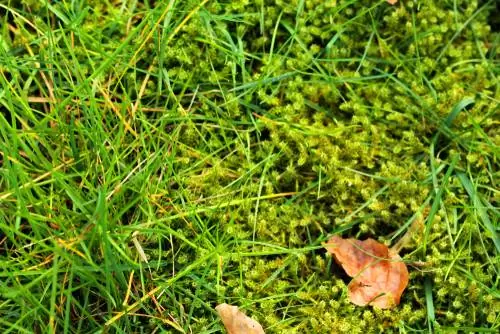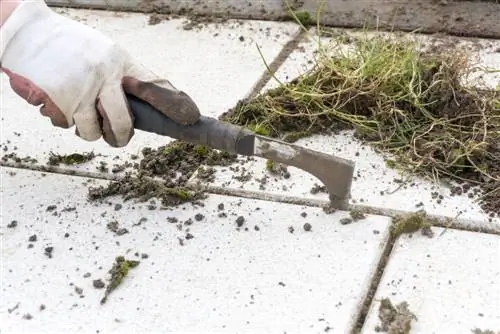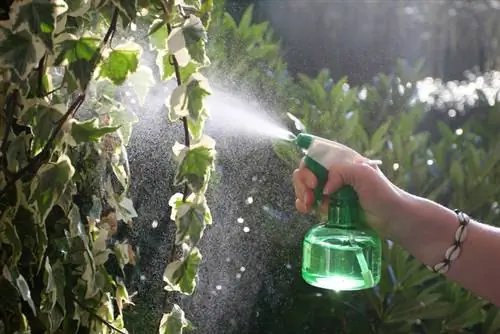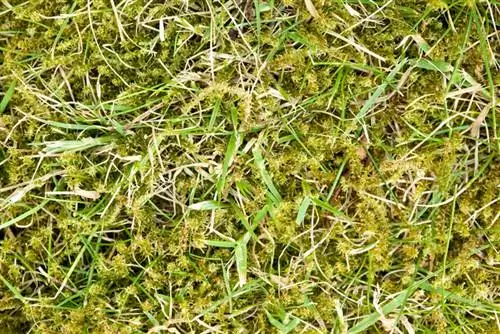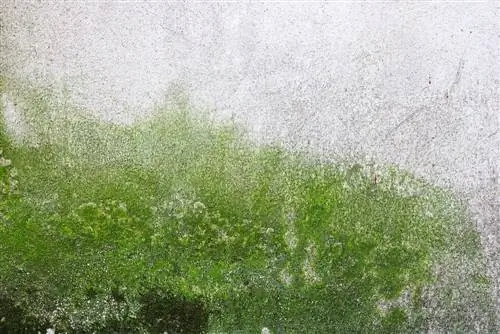- Author admin [email protected].
- Public 2023-12-16 16:46.
- Last modified 2025-06-01 06:02.
Moss in the lawn is a Sisyphean task for many a garden owner. Constant scarification and fertilization must be carried out in order to keep the lawn grass-heavy and nicely homogeneous. However, you can also take specific measures to prevent it and save yourself a lot of follow-up work.
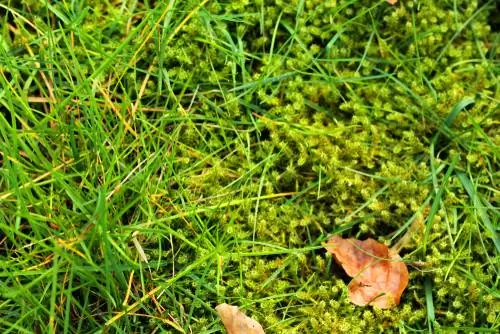
What can I do about moss in the lawn?
Moss in the lawn is a sign of nutrient deficiency. If the lawn has too little nitrogen, it tends to become mossy. First, combat the cause of the moss infestation and ensure adequate ventilation. It is recommended to scarify the lawn.
Why does moss grow in the lawn?
Mosses, like all plants, prefer to grow under certain conditions. And they are generally opposite to those favored by grass. This means that good conditions for mosses not only ensure that they spread quickly and thus displace grasses, but also create poorer conditions for grass growth from the outset. What promotes the spread of moss in the lawn are, on the one hand, planting and care errors and, on the other hand, unfavorable location characteristics.
Installation or care errors:
- Inferior lawn seed mixes
- Too low cut
- Neglected watering
Unfavorable location characteristics:
- Loamy, wet soil
- Conditions too shady (due to trees and high hedges)
- Too high acidity in the soil (low pH value)
- Soil nutrient deficiency
Many mosses thrive in locations that are moist, shady, acidic and have low vegetation on the soil surface. A lawn on clay soil with a lack of nutrients, which is overgrown by tall trees and is often mown very short, is the ideal scenario for weak turf formation and intensive moss spread.
Successfully remove moss from the lawn
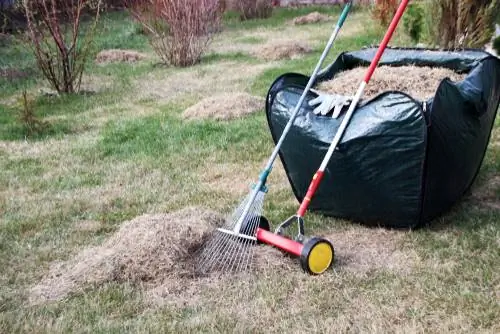
You can successfully combat moss with a scarifier
In order to properly remove existing moss, it must first be removed mechanically - keyword: scarifying. There's basically no way around it. But to save yourself the sweaty backbreaking work with a handheld device, you can also use an electrically operated device.
Then it’s time to tackle the causes.
Clay soil and moisture
A garden soil that is generally clayey and heavy also holds a lot of water. Such soil has good conditions for moss, but poor conditions for grass. In order to compensate for the toughness and the tendency for water to accumulate, the soil must be improved with sand. To do this, apply a 2 to 3 cm thick layer of coarse sand before sowing or if the lawn already exists in the spring. With quartz sand you provide the soil with good aeration and loosening material.
To make the soil permanently more grass-friendly and less moss-friendly, repeat the sanding over a period of 3-5 years.
Shadow
Tall trees in and around the garden are also moss-friendly and grass-unfriendly at the same time. With this problem, compromises usually have to be made. Of course, you don't want to cut down all the trees in the garden just to avoid moss. But that is not necessary either. Shrubs and trees that have become too tall can also be cut back or trimmed. This can provide significantly more light on the floor.
Low pH
You can use a quick soil test to determine whether your soil is acidic. A low pH value is not necessarily friendly to moss, but rather unfriendly to grass. Moss thrives equally well on acidic and calcareous soils. Lawn grass, on the other hand, is no longer well suited to soil with a pH value below 5 and is quickly displaced by moss. If the soil environment is acidic, it is advisable to counteract this with lime. The correct dosage depending on the measured pH value can be found in the instructions for the lime preparation.
You can find various products for liming in specialist stores:
- normal garden lime: for heavy garden soil, consisting of carbonated lime and some magnesium
- Primitive rock flour: Potassium and some valuable trace elements, dosage for acidic soils: 200 to 300 g per m²
- Algae lime: obtained from coral deposits of red algae, carbonate of lime and many trace elements, is applied during the growing season
Nutrient Deficiency
If you are dealing with a nutrient deficiency, especially a potassium deficiency in the soil, the lawn needs to be strengthened. This gives it the opportunity to form a more closed turf and allow less moss to grow through gaping gaps.
First of all, lawn fertilizers containing potassium are suitable, as they make the grass more stable and resilient. In spring and summer you should supply the lawn with organic slow-release fertilizer. In addition, it makes sense to use ammonia and - if there is a low pH value in the soil - lime to ensure stronger grass growth.
Here is an overview of the most important measures against moss-promoting conditions:
| Wet clay soil | Shadow | Low pH | Nutrient Deficiency | |||
|---|---|---|---|---|---|---|
| Countermeasure | Regular sanding | Possibly. Pruning of surrounding trees/shrubs, in some places avoiding lawn (ground cover) | Lime treatment per acidification | Regular long-term fertilization |
Tip
Proceeding correctly when planting a lawn is half the battle. If the ground is still bare, you can compensate for unfavorable ground conditions in advance. To create a solid, competitive turf, don't skimp on the grass seed mix. Inferior cheap products mainly contain fast-growing forage grasses that have little to counteract moss.
So that the lawn can capture enough light, mow it regularly, but not too short. Otherwise too much leaf mass will be taken away.
In dry periods, provide the lawn with water regularly.
Here are some basic tips for biological control of moss from a lawn expert:

Remedies against moss or lawn fertilization that should be viewed critically
You should not use chemicals to combat moss or fertilize your lawn. The following is problematic:
- Limetic nitrogen
- Bluegrain
- Iron fertilizer
- Ashes
Limetic nitrogen
Fertilizing the lawn with calcium cyanamide can be quite effective, but it is very difficult for laypeople to dose without causing the lawn to burn. The toxic agent, which is often used as a herbicide, is therefore less recommended for existing lawns. More likely for new lawns. In this case, a good supply of nitrogen can be created in the soil using calcium cyanamide.
Bluegrain
Because it is relatively inexpensive and has a kind of all-inclusive character, blue grain fertilizer is popular with many gardeners. Lawns can also be fertilized with blue grain, but the mineral NPK supplier must be handled carefully. The problem with blue grain is the chemical production of the nitrogen compounds it contains, which in the long term pollute the global biosphere and promote the growth of algae in inland waters. In addition, overdoses can quickly occur with blue grain, which leads to root burning - the lawn-strengthening effect is then literally reversed.
Iron fertilizer
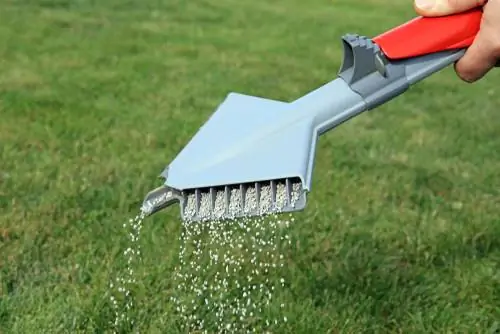
Iron fertilizer strengthens the lawn and weakens moss
Strengthening the lawn with iron fertilizer and combating moss at the same time only makes sense under certain conditions. On the one hand, you should have clearly established that there is an actual iron deficiency in the soil. Only then is it advisable to use iron sulfate to combat moss. Weak plants can also suffer from iron deficiency due to lime chlorosis. It is only their ability to absorb enough iron that is actually present that is inhibited by too much lime (e.g. from chalky watering/sprinkling water).
Moss can be effectively controlled with iron fertilizer because the plants are generally very sensitive to all forms of iron. However, if you apply fertilizer with iron II sulfate, you should not allow children or pets on the lawn for at least 3 to 4 days afterwards. Preparations containing iron sulfate are toxic and corrosive. Therefore, you should also wear protective clothing and gloves when spreading.
Ashes
It is always recommended to use ash to combat moss. The moss is actually weakened by sprinkling it with ash and can be easily removed soon after application. However, ash also contains many pollutants, even relatively “clean” wood ash. These naturally end up in the soil, damaging the grass and disrupting the biological balance of the soil. You should only use ash to combat moss in paving joints.
The types of moss in your lawn
Of course, not all species of the huge group of mosses are relevant to local gardening. However, moss species from all three major departments can generally be found in our gardens. The departments into which mosses are classified are called:
- Masses (botanically Bryophyta)
- Liverworts (botanically Marchantiophyta)
- Hornworts (botanical Anthocerotophyta)

In our gardens and especially in the lawn, representatives of the mosses are the most common. The group in turn includes an enormous number of subdivisions, orders, classes, families and genera. A total of around 15,000 species can be counted in this department. The following are more common in Central European latitudes:
- Sparrow wrinkled brother (Rhytidiadelphus squarrosus): Most common species that leads to extensive matting in the lawn
- Common shortbush moss (Brachythecium rutabulum): Strongly branched, needle-like forest moss, very common
- grove peat moss (Sphagnum capillifolium): Pretty heather moss with round, thick heads
- Spike peat moss (Sphagnum cuspidatum): relatively large and delicate, weak-stem habitus, yellowish-green, likes to grow in very moist locations
- Very fruity leske moss (Leskea polycarpa): Likes to grow over trunks and floors with deep green carpets
Of the 10,000 species of liverworts, the following are particularly common in our country:
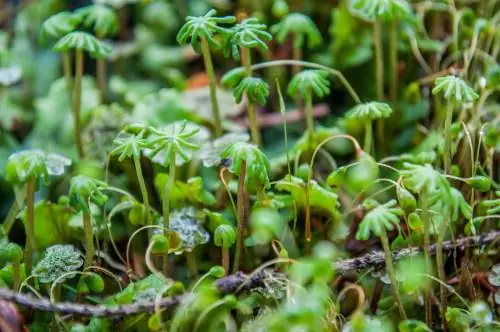
The fountain liverwort looks like small mushrooms
- Fountain Liver Moss (Marchantia polymorpha): Ribbon-like thallus with midrib and notched edges, wide breeding cups
- Delicate liverwort (Monosolenium tenerum): is often used as decorative moss for aquariums
- Bidentate comb moss (Lophocolea bidentata): common lawn moss that is very drought-resistant
Hornmosses are less common here.
Annoying types of moss in the lawn
The ones that most often act as grass displacers in garden lawns are the Sparrigen wrinkled brother and the two-toothed comb moss. Both are strong grass displacers and grow on both poor and nutrient-rich soils. They particularly like moist, shady locations, but bidentate comb moss in particular can also survive longer dry phases.
Background
The world of mosses
Mosses are initially a thorn in the side of many garden owners. But if you take a closer look at them, you can become fascinated by the amazing plants. Mosses are indeed a very special species in the plant world.
First of all, it is exciting that there are still some gaps in their research. They are one of the Methuselahs of the planet's land plants, which is why scientists rely on fossil evidence to study them. Today it is believed that mosses were the pioneers in the transition from water to land colonization of plants. They probably arose from green algae on the sea coasts - around 400 to 450 million years ago.
Mosses have a relatively simple structure and are therefore very frugal and adaptable. Most species prefer shady, moist locations and can reproduce generatively via spores.
Their dogged adaptability to survive also leaves a lot of room for interpretation: despite their love of water, which they absorb as well as nutrients primarily through their above-ground plant parts (they don't have any real roots), some moss species can survive long dry periods surprisingly well outlast. Some species have even adapted to particularly barren, dry rocky or desert regions.
Mosses also have two aces up their sleeves when it comes to reproduction: in addition to generative reproduction via spores, they can also reproduce vegetatively, which is necessary in locations where only one gender is represented. Mosses can form breeding bodies on practically all parts of plants.
Frequently asked questions
How can you permanently remove moss from your lawn?
Stubborn moss can be quite annoying and labor-intensive. If the conditions in the garden are unfavorable (or favorable for the moss), the moss can always gain the upper hand over the grass and require the use of a scarifier.
Unfavorable conditions for a grass-rich, moss-free lawn are, above all, a lack of nutrients in the soil, a loamy, heavy and wet soil condition, too much shade and a pH value that is too low. To get rid of moss permanently, it's best to take consistent action against these conditions.
Lack of nutrients causes weak grass growth, while moss copes better with it and then quickly takes over. A regular supply of nutrients through long-term fertilizer containing potassium is therefore advisable.
A heavy clay soil that tends to become waterlogged is best improved with sand over several years to loosen it and make it more permeable.
Conditions that are too shady are not always easy to fix. If you don't want to radically say goodbye to tree and shrub planting, you can do a lot with thinning and cutting back.
A low pH value also weakens the lawn grasses and reduces their ability to compete with moss. Soil acidification should therefore be counteracted by applying lime.
How can moss from the lawn be removed in a biological/environmentally friendly way?
Probably the most environmentally friendly method for removing moss because it is purely mechanical is and remains scarifying and the accompanying soil improvement and lawn strengthening with gentle means. It is also the most durable. If you are reasonably fit, use a scarifier or a simple iron rake to remove the moss for the first time. With an electrically operated machine you can save yourself a lot of sweaty backbreaking work.
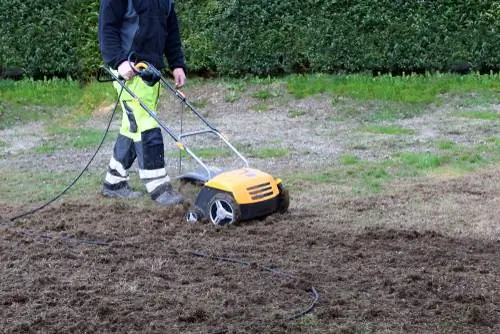
When it comes to moss, nothing beats a scarifier
You can also use vinegar to remove moss - it is not really harmful to the environment, but in the long term it leads to acidification of the soil, which in turn is a jump-start for new moss formation. With hot water, larger, homogeneous moss carpets can be weakened a little, even without pollutants.
There are numerous environmentally friendly means for accompanying soil improvement and lawn strengthening. Heavy soils can be improved with sand, nutrient-poor soils can be supplied with manure, primary rock powder and compost.
Is it possible to remove moss without having to scarify?
Unfortunately, you can hardly avoid scarifying. If you want to get rid of the moss permanently, mechanical removal is the most important measure. However, you can make the work a little easier by weakening the moss beforehand using certain means.
This can be done, for example, with vinegar, hot water or soda. Herbicides are of course out of place when there is moss in the lawn because they also attack the grass plants.
Can moss be removed with home remedies?
To a certain extent, moss can be weakened with home remedies, but due to various side effects they are usually more advisable for moss in paving joints or on wooden surfaces.
Moss is sensitive to vinegar. But because acid gets into the soil, conditions that are unfriendly to grass are created in the long term, which leads to new moss formation.
Soda is often recommended as a home remedy for weeds. It also has a very visible effect due to its ability to remove nutrient s alts from plants. To ensure that the same thing doesn't happen to grass plants growing right next to them, the method is only suitable for homogeneous moss areas or paving joints.
Ash can also attack moss, making it easier to remove. The problem with ash is that it also contains some pollutants that get into the ground when spread and disrupt the soil environment and grass growth.
Treating moss with hot water has at best a weak effect. This cannot really make scarifying easier.
Fertilize, mow and water the lawn - but when?
So that the lawn becomes nice and strong, you should supply it with fertilizer in the spring. To do this, use an organic long-term fertilizer that lasts until summer. Then you can give the lawn a second helping.
You should mow the lawn about weekly during the growth phase, but not too short! 4 centimeters is the absolute minimum.
Water is also beneficial for moss, but it is also essential for he althy, strong grasses. If they are stressed by drought in summer due to a prolonged lack of precipitation, this weakens them greatly. Therefore, blow it up regularly in the morning or evening when there is such a dry phase.
Can moss be put in the compost?
In principle yes, but only if certain composting rules are adhered to. If the entire mass of combed out moss is simply thrown onto an open compost heap, no proper decomposition process can take place, which also destroys the spores.
So that a hot rot is formed that kills the moss' spreading bodies, pile the material in thin, dense layers on the compost. The individual layers of moss should alternate with layers of other different garden and kitchen waste such as shredded shrub cuttings, leaves, raw vegetable scraps or eggshells. Some temporarily stored garden soil also promotes stringent rotting. In order to enrich the compost with trace elements, it is advisable to sprinkle it with primary rock powder.

